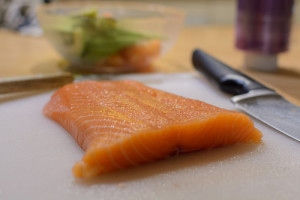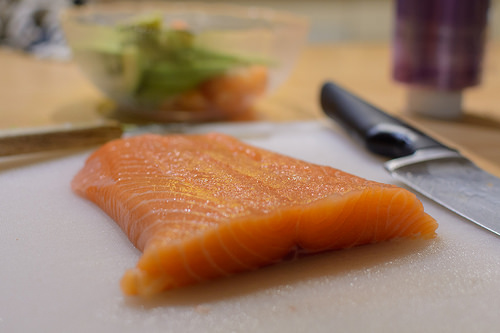Short Answer:
Yes, Salmon is Paleo!

The Popular and Nutritious Salmon
Salmon is an anadromous fish that is born in fresh water, migrate to ocean and returns to freshwater to spawn. It can be found in both Atlantic and Pacific oceans as well as inland lakes. The flesh of the salmon fish varies in color from pink, red and orange and has a delicate, sweet taste.
Salmon is an oily, fatty fish and is considered to be one of the healthiest fishes around due to its high protein, omega 3 fatty acids and vitamin D content. It supplies minerals such as calcium, iron, zinc, niacin, selenium and vitamins B6 and B12.
Like other fishes, it can be consumed in fresh form, baked, broiled, smoked or grilled.
Health Benefits of Salmon
Eating salmon can provide a wide range of health benefits.
Omega 3 Fatty Acids
Salmon is rich in Omega 3 fatty acids and has an outstanding Omega 3 and 6 ratios. Omegas 3s are known to have anti-inflammatory properties and can promote cardiovascular health. Other benefits from omega 3 consumption are joint protection, eye health and decreased cancer risk.
Protein and Amino Acids
Salmon is a complete source of protein too. Protein helps in repairing and rebuilding body cells. Protein in salmon is also digestible and easily absorbed by the body. Based on recent studies, salmon contains small bioactive protein molecules called bioactive peptides that provide support for joint cartilage, insulin effectiveness and control of digestive tract inflammation.
Selenium
Selenium is a mineral that helps in proper thyroid function. It also helps in boosting immune system and destroys harmful free radicals. Salmon is high in selenium and low in mercury. Selenium binds with mercury which protects the body from harm.
Eye Health
Omega 3 fatty acids together with amino acids help in preventing macular degeneration, loss of vision and eye fatigue.
Brain and Nerve Functions
Salmon consumption can increase brain functions and improve memory because of the omega 3 fatty acids it contains. Vitamins A and D and selenium in salmon can protect the nervous system from damage related to aging, can act as anti-depressant and helps in treating Alzheimer’s and Parkinson’s diseases.
Cardiovascular Health
The omega 3 fatty acids in salmon help in cholesterol reduction and lowering blood pressure. It also decreases the risk of heart attack.
Farmed vs. Wild Salmon
Salmon is a healthy option when wanting to have a healthy diet. But not all salmons are created the same. Contaminants and risks can sound alarming when choosing the salmon to be incorporated into ones diet. Confusion also comes in with the differences between farmed and wild salmon.
Farmed salmon makes up about 80% of total salmon in the market. Farmed salmon is confined and fed with formulated protein pellets. Wild salmon on the other hand accounts for 20% of the remaining population of salmon in the market. It is caught in the wild, in its natural environment.
Difference Between Farmed and Wild SalmonNutrition
The difference in the nutritional valued of farmed and wild salmon is significant. Farmed salmon is higher in fat and slightly more in Omega 3 and much more Omega 6. Because farmed salmon are fed with pellets, they contain more vitamins C. Wild salmon is higher in minerals and protein and have fewer calories. The ratio of omega 6 to omega 3 in farmed salmon is about three times higher than wild salmon.
Contaminants
Fishes are very prone to harmful contaminants from their environment. Farmed salmon contains higher concentration of contaminants than wild salmon. Some of these contaminants are PCBs or polychlorinated biphenyls and dioxins. PCBs are associated with cancer and other health problems. PCB concentrations in farmed salmon were found to be eight times higher than in wild salmon.
Antibiotics
Farmed salmon comes with the uncertainty of the use of antibiotics. Antibiotics in farmed fish lead to resistance to their effects. Wild salmon are never treated with any of these antibiotics.
Environment
Fish farming can have serious harmful effects. Salmon which are bred inside net cages are known to leach pesticides, viruses and antibiotics. The spread of sea lice is another risk of fish farming that lead to the death of 80 percent of local salmon.
The Bottom Line
Salmon is stellar for one’s health and both farmed and wild salmons offer significant nutrients. But the wild salmon is a better option. Farmed salmons are high in contaminants and the risks associated with them are higher compared to the concerns about wild fish.
What Experts Say About salmon… Is It Paleo?
“In addition to reducing the risk for heart disease, regular consumption of fish or supplemental omega-3 fatty acids may be helpful in preventing, treating, or improving a wide variety of diseases and disorders, including but not limited to virtually all inflammatory diseases (any disease ending with “itis”), rheumatoid arthritis, inflammatory bowel disorders (Crohn’s disease, ulcerative colitis), periodontal disease (gingivitis), mental disorders (autism, depression, postpartum depression, bi-polar disorder, borderline personality disorder, impaired cognitive development in infants and children), acne, asthma, exercise induced asthma, many types of cancers, macular degeneration, pre-term birth, psoriasis, insulin resistance, type 2 diabetes, cancer cachexia, intermittent claudication, skin damage from sunlight, IgA nephropathy, lupus erythematosus, type 1 diabetes, multiple sclerosis, and migraine headaches.” – Dr. Loren Cordain
“Eat up to 12 ounces (2 average meals) a week of a variety of commonly eaten fish and shellfish found consistently low in mercury, including shrimp, canned light tuna, salmon, pollock, and catfish” – Chris Kresser
“smoking salmon at a high heat protected the omega-3s from oxidizing to a greater extent than leaving it alone, even if antioxidants were added to the fresh salmon oils. That said, when heating the smoked salmon fat past 75 degrees C, peroxides formed at a faster rate than in the fresh salmon fat”. – Mark Sisson
All you ever wanted to know about Salmon and Paleo
Mark’s Daily Apple. Salmon: Factory Farm vs. Wild
http://www.marksdailyapple.com/salmon-factory-farm-vs-wild/#axzz3gPHXailt
Mark’s Daily Apple. Is It Primal? – Smoked Salmon, Nutritional Yeast, 5-Hour Energy Drinks, and Other Foods Scrutinized
http://www.marksdailyapple.com/primal-paleo-smoked-salmon-nutritional-yeast-5-hour-energy-drinks-brine-kremelta/#axzz3gPHXailt
The Paleo Dit. Omega 3 Fatty Acids
http://thepaleodiet.com/omega-3-fats-fish
Paleo Grubs. 8 Healthy Baked Salmon Recipes
http://paleogrubs.com/baked-salmon-recipes
Original Eating. Salmon
http://www.originaleating.com/paleo-diet-food-list/seafood/salmon/
The Paleo List. Is Smoked Salmon Paleo?
http://thepaleolist.com/2014/02/12/is-smoked-salmon-paleo/
Paleo Porn. Is Salmon Paleo?
http://paleoporn.net/q/is-salmon-paleo/
Organic Facts. Health Benefits of Salmon
https://www.organicfacts.net/health-benefits/animal-product/health-benefits-of-salmon.html
Did we miss anything?
Comment below and let us know what you think. Do you agree with our conclusion?
photo credit: Salmon

